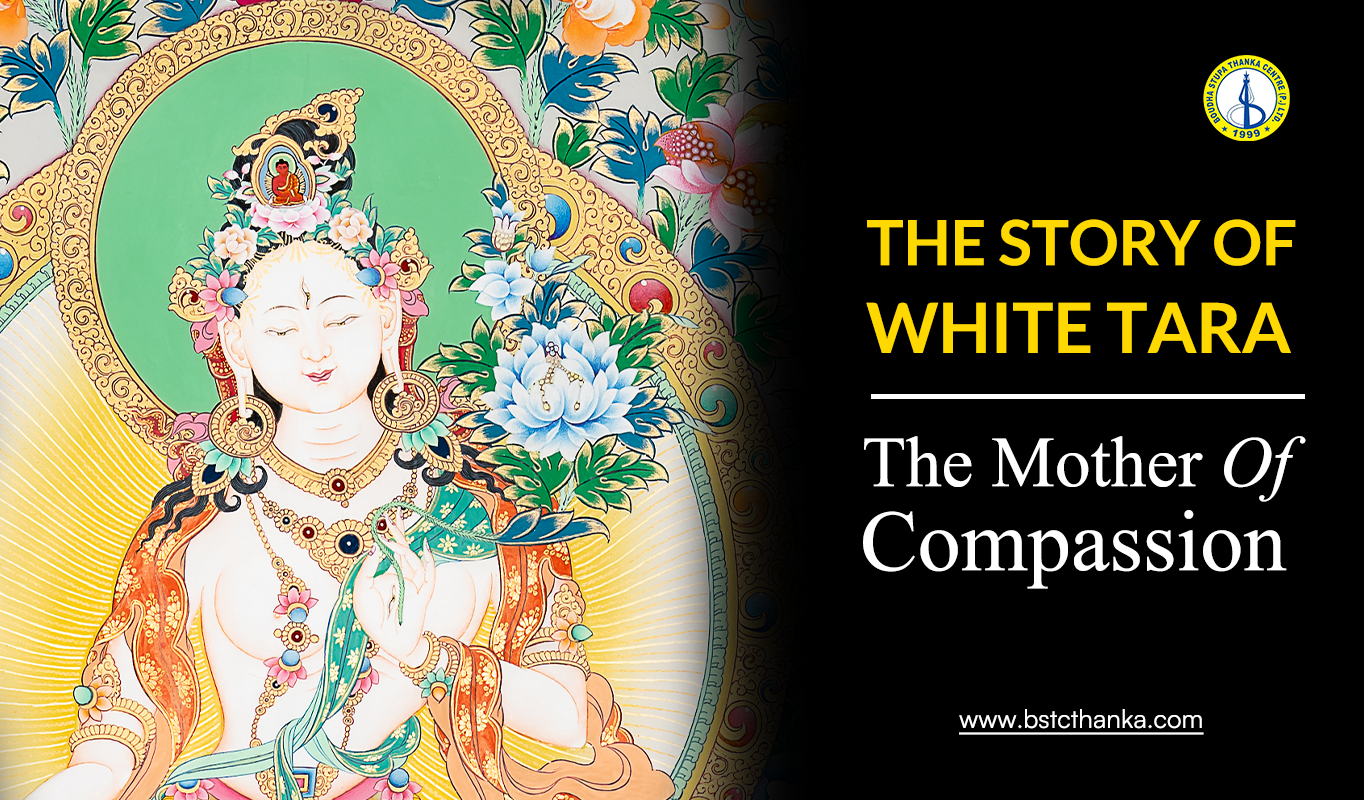
The Story of White Tara: The Mother Of Compassion
In the vast and colorful world of Tibetan Buddhism, few deities are as revered for their profound healing qualities and ability to bring longevity as White Tara. She is one of the most significant female Buddhas in Tibetan Buddhist practice, often depicted as a serene figure with seven eyes, embodying wisdom, compassion, and vitality. In this article, we will explore the White Tara meaning, examine her symbolism in spiritual Thangka meanings, and discuss how she inspires meditation and healing. We will also provide insights on incorporating White Tara into your daily spiritual practices, enhancing both physical and mental well-being.
Who Is White Tara in Tibetan Buddhism?
White Tara, known as Sita Tara in Sanskrit, is one of the most beloved and prominent female deities in Tibetan Buddhism. Her significance goes beyond mere artistry or decorative appeal; she represents an important aspect of the Buddha's wisdom, focusing on compassion, healing, and longevity.
Origins and Significance
The origin story of White Tara is deeply rooted in Tibetan Buddhist mythology. White Tara, along with her counterpart Green Tara, originated from the tears of Avalokiteshvara (Chenrezig), the Bodhisattva of Compassion. According to Tibetan Buddhist scriptures, Avalokiteshvara wept out of compassion for the suffering of sentient beings. These tears transformed into the figure of Tara, symbolizing the compassionate action needed to alleviate suffering.
While Green Tara is often depicted as a protector who acts swiftly to remove obstacles and provide safety, White Tara embodies a more nurturing aspect. She is specifically associated with healing, longevity, and the removal of physical and mental suffering. White Tara's main role is to guide beings toward spiritual awakening and provide a long life of peace and health. She is also seen as the one who offers protection and compassion for practitioners facing adversity.
In Tibetan culture, White Tara is regarded as a deity who offers powerful blessings, particularly for those who seek to overcome sickness, hardship, and obstacles in their lives. Her prayers are often used in rituals that focus on promoting longevity and overall well-being.
White Tara’s Role in Tibetan Buddhism
White Tara is known as a protector of life and health, a deity who can heal the body and mind. Her spiritual energy is believed to have the power to remove sickness and extend the life of those who seek her blessings. In Buddhist rituals and ceremonies, practitioners often invoke White Tara for protection against diseases, accidents, or other life-threatening obstacles. Furthermore, the White Tara mantra is often recited to help remove the effects of negative karma, ensuring peace and serenity in one's life.
As a goddess of longevity, White Tara is also associated with the ability to bring an individual closer to enlightenment, not just through physical healing, but also through the development of wisdom and compassion.
Symbolism of White Tara in Thangka Art
In Tibetan Buddhism, Thangka paintings are revered as not only visual representations of deities but as sacred tools for meditation and spiritual practice. White Tara, in particular, holds a significant place in Thangka art, where her depiction is laden with rich symbolism that reflects her qualities as a deity.
The Seven Eyes
One of the most notable features of White Tara’s portrayal in Thangka paintings is her seven eyes. These eyes are positioned on her forehead, palms, and soles. The seven eyes symbolize her ability to see the suffering of all beings and her compassionate vigilance. The eyes also represent her heightened awareness, as she is capable of perceiving the world’s suffering and responding with boundless love and healing energy.
The eyes on the palms and soles signify her ability to see and heal suffering through action, while the eye on her forehead represents her higher, spiritual awareness, her omnipresence as a compassionate protector.
The White Color
The color white is deeply symbolic in Buddhist art and particularly in the depiction of White Tara. White represents purity, clarity, and the transcendence of ignorance. The color is a direct reflection of Tara's purity, untouched by the impurities of the world. It also conveys her role as a purifier of both the mind and the body, freeing practitioners from the fetters of suffering.
In Tibetan Buddhist philosophy, white is also seen as a color of enlightenment. It is linked with the idea that through Tara's wisdom, practitioners can attain a state of peace and enlightenment free from the disturbances of ego and material distractions.
The Lotus and Moon Disk
White Tara is often depicted sitting on a lotus, which is an enduring symbol of spiritual growth and purity in Buddhist iconography. The lotus grows in the mud but rises above it, symbolizing the journey of the soul from ignorance to enlightenment. For White Tara, the lotus under her feet also signifies her transcendence over the ordinary world, where suffering and ignorance abound.
Additionally, a moon disk often rests beneath White Tara, further symbolizing her connection with calming, cooling compassion. The moon's light represents clarity and tranquility, reinforcing her role as a nurturing force that provides comfort and serenity in times of suffering.
How White Tara Inspires Meditation and Healing
One of White Tara's most revered aspects is her ability to inspire healing, both physical and spiritual. Her practice in meditation is deeply intertwined with the cultivation of inner peace, longevity, and protection against illness.
Meditation on White Tara
Meditating on White Tara is a practice that enables practitioners to connect with her compassionate energy and receive her blessings. In Tibetan Buddhism, meditation is a vital component of spiritual growth, and White Tara’s meditation is especially beneficial for those seeking to heal or enhance their longevity.
Visualization Practice
A common meditation technique involves visualizing White Tara in her full form. Practitioners may visualize her seated in a serene lotus position, surrounded by a radiant white light. This light is thought to heal the body and mind, dissolving all negativity, obstacles, and sickness.
In this meditation, it is often suggested to focus on the seven eyes, which are symbolic of White Tara's omnipresent compassion and her ability to heal. With each breath, one may visualize the light from her eyes entering their body, healing ailments, and offering comfort.
White Tara’s Healing Energy
White Tara’s healing power is not just symbolic but also active. Her energy is believed to enter practitioners’ bodies during meditation, bringing with it the ability to eliminate negative emotions, physical illness, and mental suffering. Whether someone is seeking physical health, emotional balance, or spiritual enlightenment, White Tara’s compassion is felt during each moment of meditation.
Healing Mantras and Chants
The mantra Om Tare Tuttare Ture Mama Ayur Punye Jnana Pushtim Kuru Soha is one of the most powerful ways to invoke White Tara’s healing presence. Repeatedly chanting this mantra is believed to bring White Tara’s blessings of long life, health, and wisdom. Each syllable of the mantra corresponds to specific healing qualities, helping practitioners maintain a balance of body, mind, and spirit.
Incorporating White Tara into Daily Spiritual Practices
Incorporating White Tara into your daily life allows you to maintain a continual connection with her healing and compassionate energy. Below are some practical steps for integrating White Tara into daily spiritual routines.
Daily Mantra Recitation
One of the easiest ways to connect with White Tara daily is through the recitation of her mantra. This can be done in the morning to start the day with peace and intention, or before bed to calm the mind and body. A mala (prayer beads) can help in keeping count while meditating on her mantra, allowing the repetition to naturally guide one into a deeper meditative state.
Incorporating White Tara into Meditation
Setting aside a few minutes each day to meditate on White Tara can enhance one's spiritual well-being. Whether you're seated in a meditation posture or simply closing your eyes and visualizing her presence, the act of connecting with White Tara will bring a sense of calm and rejuvenation.
You can visualize her form and imagine her seven eyes gazing upon you, filling you with compassion, or you can focus on the white light emanating from her, bringing healing to your body and mind.
Displaying White Tara Thangka Art
Placing a Thangka of White Tara in your home or meditation space can serve as a constant reminder of her presence. The visual representation of White Tara creates a peaceful environment conducive to meditation and reflection. Thangkas act as focal points that help deepen your connection with her energy and are often placed on altars to invite blessings.
Ritual Offerings
Incorporating ritual offerings, such as lighting incense, offering fresh flowers, or dedicating light to White Tara, can further enhance your practice. These offerings symbolize devotion and gratitude and are meant to invite Tara’s blessings into your life.
Conclusion
White Tara is not only a powerful goddess in Tibetan Buddhism but also a compassionate protector who offers longevity, health, and wisdom to all who seek her guidance. The White Tara meaning goes beyond her artistic representation; it embodies a life filled with spiritual clarity, healing, and longevity. Through her symbolism in spiritual Thangka meanings, her role in meditation, and her healing powers, White Tara provides a path to inner peace and protection.
By incorporating White Tara into your spiritual practice, you invite a profound energy of healing and compassion into your daily life. Whether through mantra recitation, meditation, or simply displaying her image, White Tara offers a profound presence that guides and nurtures. Embrace her blessings and let her teachings illuminate your path toward spiritual fulfillment and well-being.



